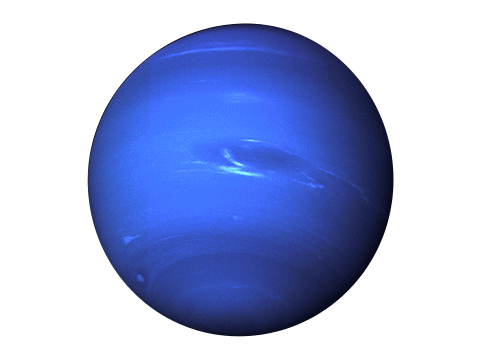Neptune is the fourth largest and the farthest planet of the Solar System with the most powerful wind speeds out of all the planets. It is the smallest of the gas giants and is the first planet to be discovered by mathematical predictions in 1846.
Keys Facts & Summary
- It is the only planet that is invisible to the unaided eye, thus it eluded ancient astronomers until it was officially discovered in 1846 by Le Verrier and Johann Galle.
- The greatest factor of the discovery was the planet Uranus, whom astronomers were calculating its orbit and observed that Uranus wasn’t following their models.
- The perturbed orbit of Uranus forced astronomer Urbain Le Verrier to conclude that another undiscovered planet must be at fault. He predicted where it should be, and astronomer Johann Galle found it one degree away from the predicted point thus making Neptune the first planet to be discovered by mathematical calculations and predictions.
- Neptune was given the name of the roman god of the sea due to its bluish-ocean like color. Its satellites also received names of water deities.
- As a result from its distance, it also has the longest orbital duration completing a trip around the Sun in about 165 years.
- However, one rotation or day on Neptune is completed in 16 hours.
Neptune
Neptune was observed in 1613 by Galileo Galilei however, he taught that it was just a star, and when he wanted to further research it, the motion of the planet began to be far too slight to be detected again. The greatest factor of the discovery was the planet Uranus, whom astronomers were calculating its orbit and observed that Uranus wasn’t following their models.
Galle proposed the name Janus, the Roman god with two faces and La Verrier proposed the name Neptune, however he did tried to name the planet after him but he didn’t have popular support outside of France. The astronomer Struve, came out in favor of the name Neptune in December 29th 1846. Soon after, it became wildly accepted. Neptune was the Roman god of the sea, identified with the Greek Poseidon as the planet appeared water-like in color.
Formation
Through simulations after the Nice model, it has been suggested that both Neptune and Uranus formed closer to the sun and later drifted away. It is hypothesized that the Solar System formed from a giant rotating ball of gas and dust known as the pre-solar nebula.
Distance, Size and Mass
From its discovery until 1930 when Pluto was discovered, Neptune was considered the farthest planet. After the discovery of Pluto, Neptune was thought to be the second furthest planet. When Pluto’s eccentric orbit was understood and its status dropped from that of a planet to a dwarf planet in 2006, Neptune regained the title of the farthest planet in Solar System.
The mass of Jupiter is about 17 times that of Earth or 1.0243×1026 kg, but when compared to the largest gas giant Jupiter, it has only 1/19th of Jupiter’s mass. It has an equatorial radius of 15.387 miles or 24.764 kilometers, about four times wider than Earth, and a diameter of 49.244 km or 30.598 mi, being the fourth largest planet of the solar system.
Orbit and Rotation
Since it is the farthest planet from the Sun it has the longest orbital duration, completing a trip around the Sun in about 165 years. However, one sidereal rotation or day on Neptune is completed in 16.11 hours.
Picture of Planet Neptune

Quick Facts
| Recorded By: | Urbain Jean Joseph Le Verrier & Johann Galle |
| First Record: | September 23rd 1846 |
| Surface Temperature: | -201 °C |
| Orbit Period: | (164.79 Earth years) |
| Orbit Distance: | 4,498,396,441 km |
| Notable Moons: | Triton |
| Known Moons: | 14 |
| Equatorial Circumference: | 155,600 km |
| Polar Diameter: | 48,682 km |
| Equatorial Diameter: | 49,528 km |
| Mass: | (17.15x Earth) |











